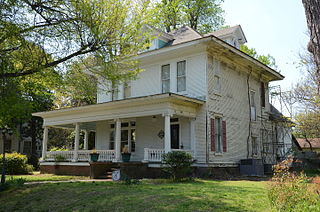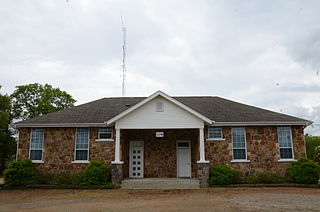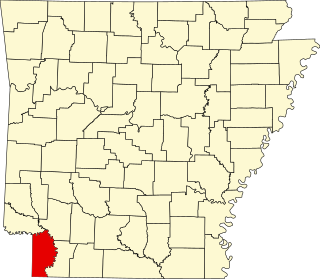
Texarkana Union Station is a historic train station in the Texarkana metropolitan area serving Amtrak, the United States' national passenger rail system. The Arkansas-Texas border bisects the structure; the eastern part, including the waiting room and ticket office, are in Texarkana, Arkansas, but the western part is in Texarkana, Texas, meaning stopped trains span both states. The station was built in 1928 and was added to the U.S. National Register of Historic Places in 1978.

The Clark County Courthouse is located at Courthouse Square in Arkadelphia, Arkansas, the seat of Clark County. It is a 2-1/2 story Romanesque stone structure which was designed by Charles Thompson and completed in 1899. It is a basically rectangular structure with a hip roof, and a six-story tower rising from the northwest corner. It has a hip roof from which numerous hipped gables project, and there are corner turrets with conical roofs. It is the county's second courthouse.

The Knob School, also called the Masonic Lodge, is a historic school and Masonic lodge building on Arkansas Highway 141 in Knob, Arkansas. It is a two-story wood frame structure with a hip roof, and a single-story extension to the front with a hip roof and a recessed porch. The building has vernacular Craftsman style, with extended eaves supported by exposed brackets. It was built in 1923 to serve the dual purpose of providing the community with school facilities and space for Masonic lodge meetings.

Hope is a passenger rail station in Hope, Arkansas. The station is located on Amtrak's Texas Eagle line. Trains run daily between Chicago, Illinois, and San Antonio, Texas, and continue to Los Angeles, California, 2,728 miles (4,390 km) total, three days a week.

The Foster House is a historic house at 420 North Spruce Street in Hope, Arkansas. The house was designed by Texarkana architects Witt, Siebert and Halsey, and built in 1918 for Leonidas Foster, a prominent local businessman, landowner, and cotton broker. It is a 2-1/2 story brick structure, with a hip roof pierced by a gable-roofed dormer. A porch supported by brick piers extends across the front facade, and is augmented by a porte-cochère on the left side. The house is an excellent local example of a Foursquare house with Craftsman and Prairie details.

The Patrick J. Ahern House is a historic house located at 403 Laurel Street in Texarkana, Arkansas.

The Cotton Belt Railroad Office Building is a historic commercial building at 312 East Broad Street in Texarkana, Arkansas. Built c. 1910, this two-story brick building is one of the oldest buildings in downtown Texarkana. Its exterior walls have been stuccoed, and it has a flat roof behind a stuccoed brick parapet. It has vernacular Italianate styling, with two-story pilasters separating the front bays, and dentil molding at the roof line. The main facade is divided into three bays, the central one providing the main entry on the first floor, and an arched-top window above. The flanking bays are plate glass on the first floor, with tripled sash windows above. The building's first tenant was the Cotton Belt Railroad, whose arrival was responsible for Texarkana's significant growth in the early 20th century.

The Claude Folke House is a historic house at 501 Pecan Street in Texarkana, Arkansas. It is a two-story brick structure with a hip roof, set on a raised corner lot. It is one of the city's most elaborate Classical Revival structures, with a monumental temple front supported by pairs of fluted Ionic columns rising the full height of the facade. The roof has an elaborate modillioned cornice, with a small triangular pediment containing a half-round window. The interior of the house contains equally impressive woodwork. The house was built in 1903 by Claude Folke, the son of railroad baron George Foulke.

The Kiblah School is a historic school building in rural Miller County, Arkansas. It is located southeast of Doddridge, at the junction of County Roads 4 and 192, between United States Route 71 and the Red River. The building is a single-story L-shaped wood frame structure, topped by a gable-on-hip roof. It has modest Craftsman styling, with some Greek Revival influences. The main entrance is sheltered by a hip-roofed porch supported by Craftsman-style columns. It has a transom window reminiscent of Greek Revival doorways. The school was built in 1927 with funding from the Rosenwald Fund, and was intended to serve the African-American community of Kiblah, which was established after the American Civil War by former slaves from a Louisiana plantation.

The Kittrell House is a historic house at 1103 Hickory Street in Texarkana, Arkansas. It is a two-story Foursquare wood-frame house with a hipped roof, set on a high brick foundation. It sits on a terraced corner lot, raised above the sidewalk level by a low wall. A full-width single-story porch extends across the main facade, supported by Ionic columns and with a balustrade of urn-shaped balusters. The house was designed by Charles L. Thompson, a noted Arkansas architect, and built c. 1900-10.

Mullins Court is a historic apartment complex at 605 Hickory Street in Texarkana, Arkansas. It is a two-story U-shaped building built of brick and topped by a hip roof. The main entry is located in the courtyard formed by the U, and is framed in limestone trim. The brick is primarily orange, although there is a course of puce bricks that serve as an accent. The building was designed by Witt, Seibert & Halsey, and was built in 1928. It was the first apartment block in the city built in the Colonial Revival style, and was named in honor of the locally prominent Mullins family.

The Ritchie Grocery Building is a historic commercial building at Front and Olive Streets in Texarkana, Arkansas. It is a two-story brick and masonry building with a flat roof and a parapet along the main facade. It was built in 1894 by Francis Mullins, owner of the Texas Produce Company, the first major grocery wholesaler in the city, founded in 1884. It is the only surviving Romanesque Revival building in downtown Texarkana, and the building was purchased by the Ritchie Grocery Company in 1926. The building was purchased in 2017 by 1894 LLC and is being renovated to its original glory. The name of the building was changed to 1894 City Market, 1894CityMarket. An art gallery is housed on the first floor, an event room on the second floor, and loft apartments on the third.

The S.S.P. Mills and Son Building was a historic commercial building at the northwest corner of Texarkana Avenue and Main Street in Wilton, Arkansas, between the railroad tracks and United States Route 71. It was a single-story panel brick building, built by a local landowner and merchant for his commercial activities. It was designed by Witt, Seibert & Company of Texarkana, and built in 1912. It was one of the few commercial buildings in Wilton to survive from the growth period after the arrival of the railroad in the city.

Aggie Hall is a historic former gymnasium in Bruno, Arkansas, a short way south of Arkansas Highway 235. It is a single-story stone structure, topped by a hip roof which has a clerestory section at its center. The clerestory is finished in weatherboard; both roof lines have Craftsman-style exposed rafter ends. The building was erected in 1926 by the student members of the Lincoln Aggie Club, believed to be the first chapter established of the Future Farmers of America, and was originally intended as a gymnasium for the adjacent Bruno School and as a location for the club's activities.

The Cedarville School Building, also known as the Old Rock School, is a historic school building on Crawford County Road 523 in Cedarville, Arkansas. It is a single-story rectangular masonry stone structure, with a deck-on-hip roof and a stone foundation. Its main facade has a recessed entry under a slightly-projecting shed roof, with three banks of sash windows to its left. The school was built in 1931, and initially served as the city's high school. The building now serves as a community center.

The Caddo Valley Academy Complex is a collection of former school buildings in Norman, Arkansas. Set well back from Main Street (Arkansas Highway 8 near the junction of 9th Street and Smokey Hollow Road, the complex includes a two-story fieldstone main building, a smaller single-story home economics building, both located northwest of 9th Street, and a large concrete block gym with a gabled roof, located across 9th Street from the other two. The main school, built in 1924, is an outstanding local example of Craftsman styling; the 1937 home economics building also has Craftsman style; the gym was built in 1951, and is vernacular in style. The school was used until the local schools were consolidated into a new facility in 1971.

The Luber School is a historic school building in rural central-southern Stone County, Arkansas. It is located at the northern corner of Luber Road and County Road 214 in the community of Luber, south-southeast of Mountain View. The school is a single story rectangular stone structure, with a hip roof that has exposed rafter ends in the Craftsman style. A hip-roofed porch projects to the south, supported by square columns, and shelters the main double-door entrance. The school was built by the small rural community in 1930, just before the full effects of the Great Depression and a drought ruined the area's economy.

The former Mountain View School, now the Russellville Fire Station No. 2, is a historic school building at 109 Hilltop Drive in Russellville, Arkansas. It is a single story masonry structure, built out of fieldstone and covered by a hip roof. Its entrance are sheltered under a project gable-roofed porch with square columns set on stone piers. The school was built in 1926, during a period of significant growth in the city's history.

The Museum of Regional History is a local history museum in Texarkana, Texas. It is the first and oldest museum in the Texarkana metropolitan area; it was established in 1971. It is located in the Offenhauser Insurance Building, which was built in 1879, making it the oldest brick building in the city.

The Ellis Building is a historic commercial building at 208 North Block Avenue in Fayetteville, Arkansas. It is a single-story brick building, with a hip roof that has a rounded top section. The roof's shape is obscured from the front by a low stepped parapet. The front facade has a former garage bay opening to the left, and a pair of plate glass display windows flanking a pedestrian entrance to the right. The building was construction about 1923, and is one of the oldest surviving automotive service buildings in northwestern Arkansas. It has housed a variety of commercial businesses since ending automotive use about 1955.


























